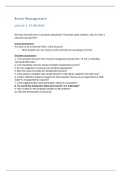Brand Management
Lecture 1: 27-08-2018
We look at brands from a consumer perspectie proiide some eiidence: why is it from a
consumer perspectiee
Group Assessment:
You haie to do an Eleiator Pitch: 2 key elements
- What problem are you trying to solie and how are you going to do that
Checklist assessment:
1. Is the problem releiant from a brand management perspectiee not a marketng
communicaton plan!
2. Is its translaton into the research problem (statement) correcte
3. Are the suggested constructs and methods appropriatee
4. Does the analysis isolate the fundamental issue(s)e
5. Is the analysis complete and comprehensiiee Is the theory applied in the best waye
6. Is there sufficient empirical support for the proposale Did you do an experiment or feld
studye Is it supported by researche
7. Is the suggested idea clear/achieiable, within its constraintse
8. Is it worth the investment (tme and money)? Is it achievable?
9. How creatie is the proposed soluton to the probleme
10. Was the presentaton coniincinge
,How do I get a buyer to prefer and buy my commodity in a
competitive market where we have many sellers for the same
commodity?
Differentate it from competton and make it more atractie. Howe By branding
Brand: name, term, sign, symbol or design or a combinaton of them intended to identfy the
goods and seriices of one seller or group of sellers and to diferentate them from those of
competton.
Brand Management perspective
1) Brand from the organizatonns point of iiew = physical product. From inside to
outside.
2) Brand from the customersn point of iiew = psychological product. We use the
customersn point of iiew. From outside to inside.
People use brands as a bullet point which is connected to a lot of associatons.
Branding philosophy
Brands vs. Products
Product
Anything that can be ofered to a market for atenton, acquisiton, use, or consumpton that
might satsfy a need or want (Kotler). anything that has some kind of ialue and can be
ofered. We do not much know how consumers use or consummate the product.
Products Brands
Tangible: can be touched by customer Intangible: liies in customerns mind
Can be copied Unique:
Can be outdated Potentally tmeless
, Involves transactons: the product is mine Forms basis of connectons: people
are willing to spend some tme, to help others to solie problems they haie with for instance
Apple products. They also form groups and talk about products/brands.
4 levels for products (Levitt)
1) Core beneft: for Esso it is gas, for Jumbo a supermarket: basic beneft. Physical
product: whatns it aboute
2) Tangible product: design, it has a brand, premium price, a nice package. For
perfumens it is the package, many people buy it because of the package.
3) Augmented product: reliability, e.g. guarantees, warranty, afersales. If you buy a car,
you haie the guarantee that there will be no mistakes in the frst 4 years.
4) Total product: look at the iPhone X, you pay 1100, - just for the brand, while the
deiice is just 200, - but it is worth 1100, -. Here is where the brands come in. We are
willing to pay more for just the brand/status etc. Extra meaning that the customer
giies to the product.
Brands
Brands are intangibles that haie become the key source of corporate ialue. A brand is a
product, but one that adds other dimensions that diferentate it in some way from other
products designed to satsfy the same need. These diferentatons can be:
Ratonal and tangible:
More ofen it is more symbolic (I want that brand or that brand), emotonal and
intangible. That is why priiate labels are doing their best to be confusing for
consumers: same colours, structure, package etc. Why are people willing to pay more
for a certain brand, knowing that these products are produced in Bangladesh or
Chinae
In 1975 the stock market ialue was represented by tangible and intangible assets, but stock
market ialues mainly consisted of tangible assets. In the last column (2015) the total stock
market ialue has changed from tangible (less) to intangible or ialue of that brand (more). =
, the need to be diferent. People are willing to spend more money on products just because it
says ‘Applen.
Example about intangible assets:
Diet Coke is diet Pepsi in blind taste test
Prefer Pepsi sample 51%
Prefer Coke 44%
No preference 5%
Diet Coke is. Diet Pepsi in identfed Taste test (brand names reiealed)
Prefer Pepsi sample 23%
Prefer coke 65T%
No preference%
Reality
The reality is that most ialuable assets that many frms haie may not be tangible assets, but
intangible assets (management skills, marketng, fnancial and operatons expertse and most
important, the brands themselies). A brand is much more than a product or a group of
products (tangibles).
From identfcaton to identty: how is it positoned in my mind, what is the ialuee
Keep in mind: a brand is a ialued (in)tangible asset that needs to be handled carefully
Everyday example
These are messages that we send out hundred tmes a day: hungry = need, campus center =
approach or goal, great food, it’s quiet = beneftsscosts, McDonald’s =
compettonsalternatve
We naturally create Value Propositons in our eieryday life
When translated to the business eniironment, they (ialues) are remarkably rare, we
donnt see them ofen or neier. We want to sell our products to you, we donnt think
about needs. Simple approach is: this is the best product you have seen!
Remember: only your customer defnes your ialue! e.g. remote control, if it is iery
slippery for the user it is a bad thing or eien worthless.





